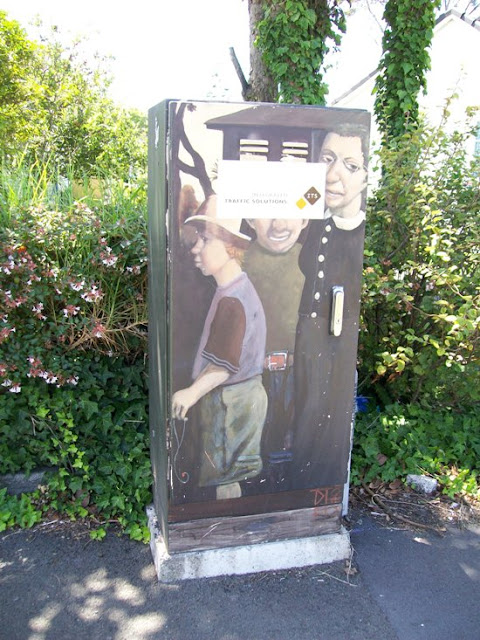Today, it is a Korean church. But, up to 2001, it was the base for
Lodge Titirangi No. 204, which now meets in Burch Street, Mt Albert.
1950s. From Avondale-Waterview Historical Society collection.
The former hall for Lodge Titirangi No. 204 at 69 Rosebank Road was once part of a three-quarter acre section purchased in the sale of the
Robert Chisholm Estate by a settler in Avondale, John Boyd. He also owned land on Rosebank for a time, up until 1892 (see the story of the
Best Varnish Works). He sold the corner site, Great North Road and Rosebank Road, to Avondale baker
Thomas Gourlay Grubb and his wife Rebecca in 1894. It's possible Grubb had already set up his business in a wooden store, at the corner with a stable at the rear (the site of today’s hall). The couple sold the property on mortgage to their son-in-law, another baker named Robert Samuel Kirkpatrick, in 1903.
Kirkpatrick didn’t own the property very long. In 1905, he sold it to grain merchants Frederick William and Joseph Robinson Smith. Frederick William Smith appears in the Wises Directory for 1905, having a grain merchants business in Commerce Street in the city. He was to own the entire corner site through to 1909.
In that year, baker Daniel Robertson bought the whole property, and utilised the stables at the Rosebank Road frontage. He in turn sold the property to an agent named Edward Austin Whittaker in 1916. It appears that Whittaker originally came from Hawera, operating an auctioneer’s business there c.1905. In Auckland, he ran a land agency business with his father until at least the mid 1920s.
What ensued then was a tangle of mortgages and sub-mortgages; one of which, a mortgage taken out by Robertson back in 1912, defaulted and led to the sale of the property on 13 May 1919 to the
Thode brothers.
On 22 May 1919, the Thodes sold the stables to Charles Theodore Pooley, Henry Potter, William Richard Thom Leighton and Alfred Morgan, the first trustees for “Titirangi Lodge No 204 of Ancient, Free and Accepted Masons of New Zealand”. Why the words “Lodge Titirangi” were transposed is anyone’s guess. Unfortunately, it meant that in common reference around Avondale as I grew up, we would call the building the Titirangi Lodge.
The Lodge itself originated from attempts over the course of eighteen months from 1913 to 1915, according to Lodge historian, Roger Hughes. Joseph Crisp, who lived on Station Road (Blockhouse Bay Road today, between the railway line and Great North Road) worked at gathering enough interest, followed by Walter Francis Brooke-Taylor, a New Lynn resident. He succeeded in gathering in 24 brethren from Avondale and New Lynn, six preliminary meetings held chaired by William Neilson Ingram, with Brooke-Taylor as secretary. In 1915, the petition to the Grand Lodge was signed, with Ingram as Lodge Titirangi No. 204’s first Grand Master.
The Thodes were most likely operating from what became known as “Thodes’ Corner” from c.1916. In February 1918, it must have appeared likely that they’d be in a position to have title at some point. A handwritten promise was made out to the Lodge on 20 February 1918:
“We, the undersigned, agree in the event of our purchasing the block of land on the corner facing Great North Road, and Rosebank Road, Avondale, to sell to Lodge Titirangi, No. 204, for the sum of £375 the built premises now occupied as a stable and the shed occupied by Mr Martin as a coal yard, and including the section on which the above premises stand to the live hedge at the rear.”
So, the Lodge Hall was probably built 1919-1920.
A rare photo of the Lodge from possibly the 1920s, from the Rosebank Road frontage. The brick building hasn't been plastered yet, and the Spanish tiled parapet hasn't been added above the door. The corrugated iron building appears to have been the old horse stable. From Avondale Historical Journal No. 14, November-December 2003. Photo from Barry Thomas.
The next change to the trustees of the Lodge’s title came in 1941. Now they were: Henry Potter, Charles Pooley, Walter Francis Brooke-Taylor, Robert Ward and Colin Albert Crum. In 1951, Pooley was replaced by John Lupton. The next change was the final one, as the Lodge made plans to sell the hall in 2001: Donald William John Brownlee, John Oldham Currie, Thomas Ure Fraser, Alan Charles Gini, and Mervyn John Nichols.
At some point, the stable to the east of the hall (a coal dealer's business in 1940) was replaced in what appears to be brick, judging by the 1950s image, and was demolished in the latter part of the 20th century. Today the site is part of a carpark. The Spanish tiled portion of the hall looks a bit odd these days now, jutting out on its own.
In 2002. the hall was purchased by the Sung Rak Church Charitable Trust, transformed into the Auckland
Sung Rak Church, and all exterior signs of the previous Masonic ownership were erased.
As for the story of the old wooden store at the corner – the Thode brothers leased the store to grocer Edward Civil in 1919, who in turn transferred his lease to Norman McKenzie in 1920 (the store then became known as McKenzies for the first part of the 1920s until the fire in 1925). The Thode brothers meanwhile sold the property to another set of brothers, the Fearons (Charles Edgar and Leonard Roger) back in 1920. When the fire razed the old store, the Fearons built the present day Fearon's Buildings.





















































